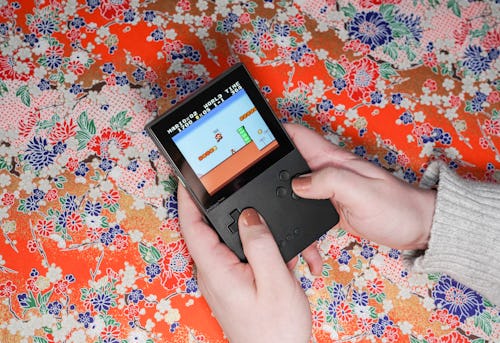
Ah, a month or so after every other outlet and influencer in the world gave their take on a review unit, tis I, Analogue's old frenemy, here to put in my two cents on their latest product, the Pocket.
If you're not familiar with Analogue, allow me to catch you up on retro gaming's hottest luxury manufacturer. Founded in 2011 by Christopher Taber, Analogue got its start by gutting old Nintendo NES and Neo Geo MVS consoles and using their parts to create upgraded, hardwood enclosed, digital-friendly versions called the Analogue NT and CMVS. Since there are a limited number of retro consoles available on the market — and game preservationists tend to get a little squicked when you start gutting and flipping them for cash — the company soon pivoted to FPGA (field programmable gate array) technology for its future releases.
An FPGA is a microchip that can reconfigure itself on the fly at the hardware level to become other kinds of chips, such as those found in older game consoles. Thus, armed with the (heavily subsidized) tech and FPGA wizard Kevin "Kevtris" Horton, Analogue soon developed the NT Mini (NES), the Super NT (SNES), the Mega SG (Genesis/Mega Drive), and the upcoming Duo (TurboGrafx-16, PC Engine CD, and SuperGrafx). All of these pale — in both ambition and execution — in comparison to the Pocket.
The Pocket is a landmark release.
The Pocket features a traditional, vertical Game Boy DMG layout and can play Game Boy, Game Boy Color, Game Boy Advance, and Game Gear games (via a cartridge adapter, sold separately), with support for Atari Lynx, Neo Geo Pocket, and Neo Geo Pocket Color on the horizon (also through adapters sold separately). Beyond retro gaming, the device also supports a second FPGA core and multiple audio applications for developers and creatives to use as they please.
The Pocket is a landmark release for the company, as well as for the larger FPGA development scene. So, does the console itself match up to its impressive pedigree?
Input may receive a portion of sales if you purchase a product through a link in this article. We only include products that have been independently selected by Input's editorial team.
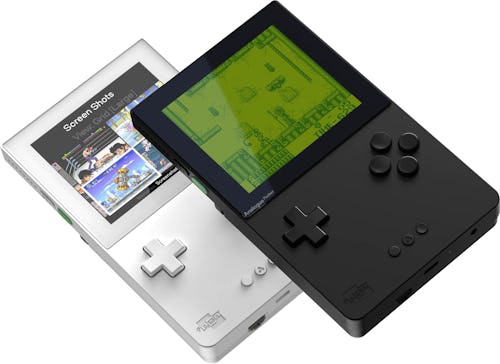
Buying hell
And we're off to a rocky start! Purchasing the Pocket back in August of 2020 was an absolute nightmare of queuing, crashed payment systems, and confusing guidance. Then came the interminable 16-month wait for the handheld to actually ship — granted, part of which was due to the ongoing supply chain crisis. Unfortunately, the situation is no better today.
The Pocket as a product and Analogue as a company both have dedicated subreddits littered with buyers nervous about what quarter (or year!) their products might ship, if they'll ever get cartridge adapters for their preferred system (we're still waiting on the Neo Geo Pocket and Atari Lynx units to get shipping dates and for the TurboGrafx-16 adapter pre-orders to even begin), and what happens in the case that something about their order goes awry.
When we're talking about games like Tetris, that's a lot of money.
Analogue has never been known as a company with good, comprehensive, or attentive customer service — something even its most diehard fans will cop to — which makes it a lot more difficult to swallow the difficult truth that is a product development cycle during a global supply chain crisis. It's not their fault… but if they could be even slightly more helpful or approachable, it might make the situation at least a smidge less painful.
When compared with emulation handheld devices like the Retroid Pocket 2 Plus, the Pocket is also wildly expensive. Yes, the actual handheld is $219.99 (up from the original $199 if you pre-ordered in 2020), but with all the accessories, you quickly hit a total of $567.87 before tax, shipping, import fees, or the actual game cartridges you'll need. To be fair, the Pocket is a luxury product and much, much nicer than any other device on the market — from its FPGA technology to its design and build — but when we're talking about games like Tetris, that's a lot of money. And that's coming from a person who owns over 200 handheld gaming devices.
Superb build
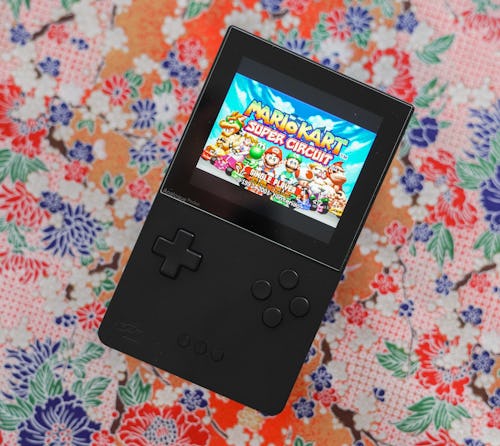
Now, about that lovely hardware… this is when my review is going to go from scathing to glowing. It's fabulous.
Let's get the specs out of the way: The Pocket features a stunning 3.5-inch LCD display at a resolution of 1,600 x 1,440 (615 ppi) with variable refresh rates, and 360-degree display rotation (tate mode). The 4,300 mAh battery supports fast charging over USB-C for a total of 6-10 hours of gameplay, according to Analogue.
The FPGA tech includes an Altera Cyclone V FPGA with 49K logic elements and 3.4mbit BRAM, an additional Altera Cyclone 10 with 15K logic elements, and two blocks of Cellular RAM (1MB) for a total of 32MB low-latency memory. The Pocket also boasts stereo speakers, remappable buttons, link cable support, and 3.5mm headphone jack (a feature you won’t find on most flagship phones like the iPhone 13 Pro, Galaxy S21 Ultra, or Pixel 6 Pro).
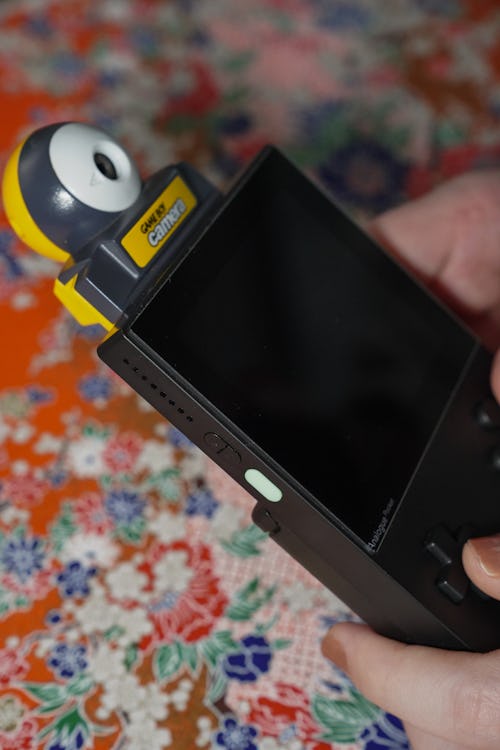
The actual device comes in black or white (I look forward to various colorways shipping in 2028, probably), features all the necessary buttons (four face buttons, D-pad, start, select, L, R) and a dedicated Analogue OS button. The unit is approximately 3.46 in (88 mm) x 5.86 in (149 mm) x 0.86 in (22 mm), putting it in the neighborhood of the original Game Boy that started it all.
I’m a big fan of its rare vertical orientation, as it keeps the display nice and high while gaming, minimizing the neck strain you might feel when craning your head down to see the Nintendo Switch. This is just one reviewer's opinion, though, and horizontal orientations have weirdly die-hard fans.
The size and heft of the device are extremely satisfying in the hand — especially if you're used to the cramped controls of a cheap emulation handheld or some of Nintendo's smaller Game Boy models like the Game Boy Advance Micro or SP. The buttons all feel fantastic, save the D-pad which feels chunky and occasionally produces unwanted directional inputs when you're really riding it during a round of Mega Man. To Analogue's credit, nobody in the industry has managed to create a D-pad as glorious as the ones featured on the '90s and early '00s Game Boys. What kind of secret Willy Wonka formula was Nintendo using?
The build quality is extremely polished, as is the design itself — open the unit up and you'll find just a single internal screw holding the device neatly together which, as a hardware modding junkie, is delightful. The finish of the casing is soft to the touch, yet avoids the weird melting/degrading issue many gaming products (like the dreaded Gizmondo) face after vigorous use.
From an engineering standpoint, the main issue the device seems to be facing is a lack of support holding cartridges in place during gameplay. This is especially problematic when using one of the device's many adapters. Analogue's focus on reverence and aesthetics are usually to its massive benefit but choosing to display each cartridge's label rather than better hold the actual games in place was a big mistake. As problems go, we'll keep our fingers strictly on the shoulder buttons and take it.
Beyond that, the Pocket is gorgeous, feels great, and comes with nearly every feature you'd want in a handheld. Oh, except Bluetooth audio. Damn. Even Nintendo came around to Bluetooth on the Switch.
High-res screen

The Pocket uses an LCD screen usually employed by VR headsets like the Quest 2. Thank goodness Analogue did, as the bright, pixel-dense screen is easily the handheld’s showstopper.
All those pixels allow the Pocket to scale games from various devices with remarkable clarity and effectively zero perceptive shimmer. The handheld's magic trick is using various modes to recreate the screens of handhelds past, such as the DMG's pea soup color or the original Game Boy Advance's washed-out palette. It's shockingly great to see in person, even if it shoots for more of a "how you remember this looking" ethos instead of a 1:1 recreation. Given the original Game Boy and Game Boy Advance's lack of a backlight, this was the obvious choice today.
The only extremely minor downside of the Pocket's screen are the black bars necessary to display Nintendo's wider Game Boy Advance games. Until we have high-quality screens mechanically folding and/or rolling themselves to various sizes, there is truly no other solution than this available — but it is worth an observation. Given the selection of systems, we'll probably play more 4:3 games anyway.
The Pocket features spectacular levels of compatibility with the many libraries of games available. Thanks to the near-perfect hardware emulation of FPGA tech, each game plays exactly as you remember it in your glory days.
Each game plays exactly as you remember it in your glory days.
Unfortunately, the Pocket seems to be finicky when it comes to compatibility with all of the popular flash cart options — which allows users to load many game ROMs to an SD card, among other cool, modern features — such as those sold by Everdrive and EZ Flash. With the price of retro games constantly ballooning, this is an attractive choice for gamers who might already be stretching their wallets to obtain the Pocket in the first place.
We can only hold out hope that Analogue and these (perfectly legal) flash cart companies get on an email chain and work this out. The people demand Shantae: Half-Genie Hero at a reasonable cost!
Beta OS
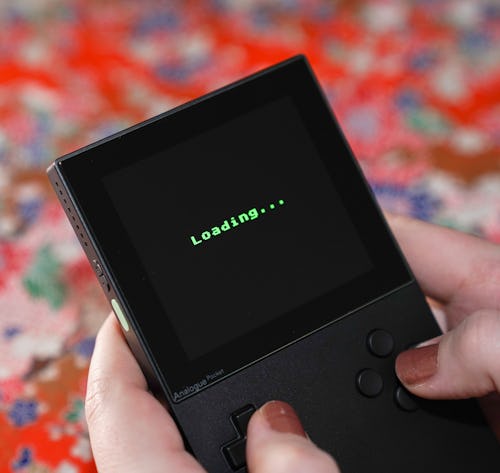
I do not think Analogue would begrudge me saying that Analogue OS, in its current (v1.0a) state, is very obviously underbaked. Key features, such as screenshots, library features, save states, and support for the vast majority of Bluetooth controllers when using the Dock are either missing or in a laughably primitive beta state.
The actual interface itself is fine, its list of white text on a black background is a chic nod to everyone's favorite theme, dark mode, and the devices’ options (such as they are) sort themselves to exactly where you'd expect to find them.
While the Pocket currently supports the .pocket files produced by GB Studio, an excellent, visual homebrew Game Boy game development app, it does not support ROM files (however you obtained them) from its microSD card slot. Analogue is likely trying to stay within the good graces of other gaming companies, though all of their other devices have mysteriously been jailbroken very soon after release. Almost as if some insiders helped such efforts along!
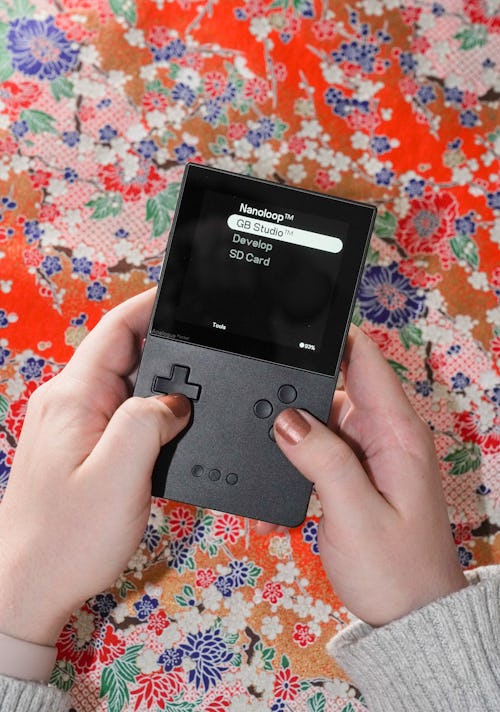
Analogue OS has yet to be jailbroken but with the device being so developer-friendly, it's only a matter of time. Until then, you're best served by picking up real, physical games (or a couple of flash carts).
Analogue OS will eventually allow third-party developers to create apps, games, and FPGA cores for the device. There's not much to say about this, though, as the features haven't yet rolled out. It also functions as a digital audio workstation and synthesizer, perfect for those of us who can't get enough of 8-bit chiptunes. Neat!
Extra goodies
Analogue has also made much of its dock accessory in the product's marketing, so let's take a moment to single it out. In my experience, the dock works exactly as advertised. It displays your games on your HDMI-compatible TV, connects to 2.4GHz wireless controllers (like those sold by Analogue's longtime partner 8BitDo), and makes for a neat charging cradle when your battery needs a top up.
Analogue also offers various high-quality accessories, like wires, charging bricks, and a plastic display case. These are mostly overpriced given their actual functionality but the same can be said of the first-party accessories from any gaming company; Nintendo used to charge an arm and leg for officially licensed Game Boy accessories.
Game Boy heir
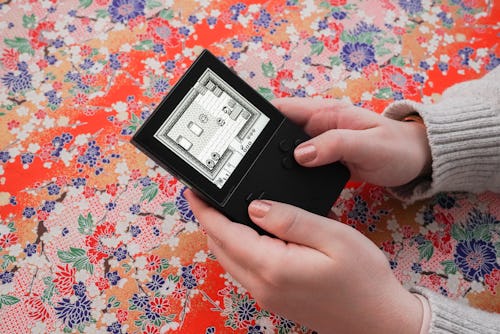
The Analogue Pocket is an excellent addition to the legacy of handheld gaming built by Nintendo, Sega, Atari, Neo Geo, and NEC in the '90s and early '00s. While it has its quirks, it is easily my favorite portable retro gaming experience. And, as the sole handheld FPGA device on the market, its bursting doors open for the technology to be explored in ways we haven't even imagined yet.
While I'd love to see Analogue contribute to open-source software like the MiSTer and level up its customer service game, I recommend the Pocket to anyone who has actually read this entire review. If you care enough about retro gaming to have found yourself at the end of this article — and if you can get past the eye-watering price tag and muster a supernatural amount of patience — you will not be disappointed in your purchase.
Now when are we getting the Analogue Duo?







